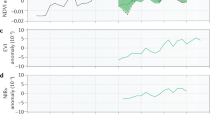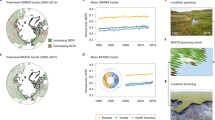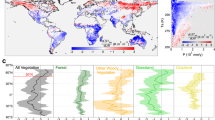Abstract
Significant land greening in the northern extratropical latitudes (NEL) has been documented through satellite observations during the past three decades1,2,3,4,5. This enhanced vegetation growth has broad implications for surface energy, water and carbon budgets, and ecosystem services across multiple scales6,7,8. Discernible human impacts on the Earth’s climate system have been revealed by using statistical frameworks of detection–attribution9,10,11. These impacts, however, were not previously identified on the NEL greening signal, owing to the lack of long-term observational records, possible bias of satellite data, different algorithms used to calculate vegetation greenness, and the lack of suitable simulations from coupled Earth system models (ESMs). Here we have overcome these challenges to attribute recent changes in NEL vegetation activity. We used two 30-year-long remote-sensing-based leaf area index (LAI) data sets12,13, simulations from 19 coupled ESMs with interactive vegetation, and a formal detection and attribution algorithm14,15. Our findings reveal that the observed greening record is consistent with an assumption of anthropogenic forcings, where greenhouse gases play a dominant role, but is not consistent with simulations that include only natural forcings and internal climate variability. These results provide the first clear evidence of a discernible human fingerprint on physiological vegetation changes other than phenology and range shifts11.
This is a preview of subscription content, access via your institution
Access options
Subscribe to this journal
Receive 12 print issues and online access
$209.00 per year
only $17.42 per issue
Buy this article
- Purchase on Springer Link
- Instant access to full article PDF
Prices may be subject to local taxes which are calculated during checkout




Similar content being viewed by others
References
Myneni, R. B., Keeling, C., Tucker, C., Asrar, G. & Nemani, R. Increased plant growth in the northern high latitudes from 1981 to 1991. Nature 386, 698–702 (1997).
Zhou, L. et al. Variations in northern vegetation activity inferred from satellite data of vegetation index during 1981 to 1999. J. Geophys. Res. 106, 20069–20083 (2001).
Lucht, W. et al. Climatic control of the high-latitude vegetation greening trend and Pinatubo effect. Science 296, 1687–1689 (2002).
Mao, J. et al. Global latitudinal-asymmetric vegetation growth trends and their driving mechanisms: 1982–2009. Remote Sens. 5, 1484–1497 (2013).
Buitenwerf, R., Rose, L. & Higgins, S. I. Three decades of multi-dimensional change in global leaf phenology. Nature Clim. Change 5, 364–368 (2015).
Pan, Y. et al. A large and persistent carbon sink in the world’s forests. Science 333, 988–993 (2011).
Liu, Y. Y. et al. Recent reversal in loss of global terrestrial biomass. Nature Clim. Change 5, 470–474 (2015).
Ukkola, A. M. et al. Reduced streamflow in water-stressed climates consistent with CO2 effects on vegetation. Nature Clim. Change 6, 75–78 (2015).
Hegerl, G. C. et al. in Climate Change 2007: The Physical Science Basis (eds Solomon, S. et al.) 667–732 (IPCC, Cambridge Univ. Press, 2007).
Bindoff, N. L. et al. in Climate Change 2013: The Physical Science Basis (eds Stocker, T. F. et al.) 867–931 (IPCC, Cambridge Univ. Press, 2013).
Cramer, W. et al. in Climate Change 2014: Impacts, Adaptation, and Vulnerability (eds Field, C. B. et al.) 979–1037 (IPCC, Cambridge Univ. Press, 2014).
Zhu, Z. et al. Global data sets of vegetation leaf area index (LAI) 3g and fraction of photosynthetically active radiation (FPAR) 3g derived from global inventory modeling and mapping studies (GIMMS) normalized difference vegetation index (NDVI3g) for the period 1981 to 2011. Remote Sens. 5, 927–948 (2013).
Baret, F. et al. GEOV1: LAI and FAPAR essential climate variables and FCOVER global time series capitalizing over existing products. Part 1: Principles of development and production. Remote Sens. Environ. 137, 299–309 (2013).
Allen, M. & Stott, P. Estimating signal amplitudes in optimal fingerprinting, part I: theory. Clim. Dynam. 21, 477–491 (2003).
Ribes, A., Planton, S. & Terray, L. Application of regularised optimal fingerprinting to attribution. part I: method, properties and idealised analysis. Clim. Dynam. 41, 2817–2836 (2013).
Lamarque, J. F. et al. Multi-model mean nitrogen and sulfur deposition from the Atmospheric Chemistry and Climate Model Intercomparison Project (ACCMIP): evaluation of historical and projected future changes. Atmos. Chem. Phys. 13, 7997–8018 (2013).
Anav, A. et al. Evaluation of land surface models in reproducing satellite derived leaf area index over the high-latitude northern hemisphere. part II: Earth system models. Remote Sens. 5, 3637–3661 (2013).
Mahowald, N. et al. Projections of leaf area index in Earth system models. Earth Syst. Dynam. 7, 211–229 (2016).
Menzel, A. et al. European phenological response to climate change matches the warming pattern. Glob. Change Biol. 12, 1969–1976 (2006).
Zeng, F., Collatz, G., Pinzon, J. & Ivanoff, A. Evaluating and quantifying the climate-driven interannual variability in Global Inventory Modeling and Mapping Studies (GIMMS) Normalized Difference Vegetation Index (NDVI3g) at global scales. Remote Sens. 5, 3918–3950 (2013).
Piao, S. et al. Evidence for a weakening relationship between interannual temperature variability and northern vegetation activity. Nature Commun. 5, 5018 (2014).
Anav, A. et al. Spatio-temporal patterns of terrestrial gross primary production: a review. Rev. Geophys. 53, 785–818 (2015).
McDowell, N. G. et al. Multi-scale predictions of massive conifer mortality due to chronic temperature rise. Nature Clim. Change 6, 295–300 (2016).
Di Vittorio, A. V. et al. From land use to land cover: restoring the afforestation signal in a coupled integrated assessment–Earth system model and the implications for CMIP5 RCP simulations. Biogeosciences 11, 6435–6450 (2014).
Kunstler, G. et al. Plant functional traits have globally consistent effects on competition. Nature 529, 204–207 (2016).
Zhang, X. et al. Detection of human influence on twentieth-century precipitation trends. Nature 448, 461–465 (2007).
Wu, P., Christidis, N. & Stott, P. Anthropogenic impact on Earth’s hydrological cycle. Nature Clim. Change 3, 807–810 (2013).
Keenan, T. F. et al. Net carbon uptake has increased through warming-induced changes in temperate forest phenology. Nature Clim. Change 4, 598–604 (2014).
Eyring, V. et al. Overview of the Coupled Model Intercomparison Project Phase 6 (CMIP6) experimental design and organization. Geosci. Model. Dev. Discuss. 8, 10539–10583 (2015).
Pinzon, J. E. & Tucker, C. J. A non-stationary 1981–2012 AVHRR NDVI3g time series. Remote Sens. 6, 6929–6960 (2014).
Allen, M. R. & Tett, S. F. Checking for model consistency in optimal fingerprinting. Clim. Dynam. 15, 419–434 (1999).
Stott, P. A. et al. Observational constraints on past attributable warming and predictions of future global warming. J. Clim. 19, 3055–3069 (2006).
Acknowledgements
This work is supported by the Biogeochemistry-Climate Feedbacks Scientific Focus Area project funded through the Regional and Global Climate Modeling Program, and the Terrestrial Ecosystem Science Scientific Focus Area project funded through the Terrestrial Ecosystem Science Program, with additional support from the Accelerated Climate Modeling for Energy project, in the Climate and Environmental Sciences Division (CESD) of the Biological and Environmental Research (BER) Program in the US Department of Energy Office of Science. Oak Ridge National Laboratory is managed by UT-BATTELLE for DOE under contract DE-AC05-00OR22725. This work is supported in part by the Fondation STAE, via the project Chavana. R.S. thanks the H2020 project CRESCENDO ‘Coordinated Research in Earth Systems and Climate: Experiments, kNowledge, Dissemination and Outreach’, which received funding from the European Union’s Horizon 2020 research and innovation programme under grant agreement no. 641816. R.B.M. is supported by NASA Earth Science Division through MODIS and VIIRS grants. B.W. is supported by the National Basic Research Program of China (Grant no. 2014CB441302). P.C. thanks the ERC SyG project IMBALANCE-P Effects of phosphorus limitations on Life, Earth system and Society Grant agreement no. 610028.
Author information
Authors and Affiliations
Contributions
J.M. conceived the study. J.M., A.R., B.Y., X.S., P.E.T. and R.S. performed diagnostics and wrote the text, with comments and edits from all authors.
Corresponding author
Ethics declarations
Competing interests
The authors declare no competing financial interests.
Supplementary information
Supplementary Information
Supplementary Information (PDF 7014 kb)
Rights and permissions
About this article
Cite this article
Mao, J., Ribes, A., Yan, B. et al. Human-induced greening of the northern extratropical land surface. Nature Clim Change 6, 959–963 (2016). https://doi.org/10.1038/nclimate3056
Received:
Accepted:
Published:
Issue Date:
DOI: https://doi.org/10.1038/nclimate3056
This article is cited by
-
Evidence and attribution of the enhanced land carbon sink
Nature Reviews Earth & Environment (2023)
-
Warming inhibits increases in vegetation net primary productivity despite greening in India
Scientific Reports (2023)
-
Avoidable heat-related mortality in China during the 21st century
npj Climate and Atmospheric Science (2023)
-
Spatial and temporal patterns of stream nutrient limitation in an Arctic catchment
Hydrobiologia (2023)
-
Investigating and predicting spatiotemporal variations in vegetation cover in transitional climate zone: a case study of Gansu (China)
Theoretical and Applied Climatology (2022)



